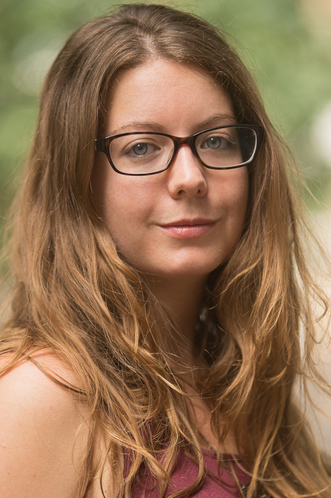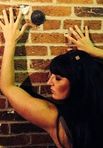Carpe Noctem Chapbook Interview With Stacey Balkun
 dancing girl press & studio, 2016 THINGS WE’RE DYING TO KNOW…
dancing girl press & studio, 2016 THINGS WE’RE DYING TO KNOW…Let’s start with the book’s title and your cover image. How did you choose each? And, if I asked you to describe or sum up your book, what three words immediately come to mind?
The three words that come to mind are “mythical creature autobiography.” I titled the chapbook after the final poem, which I feel sums up Jackalope-Girl’s quest. The cover image is by the lovely Kristy Bowen who graciously shared it from her portfolio. I was secretly hoping she’d choose this art piece, and I was ecstatic when she showed me her idea for the cover! It’s gorgeous.
What were you trying to achieve with your chapbook/book? Tell us about the world you were trying to create, and who lives in it.
Every poem in this tightly-knit collection follows a little Jackalope-Girl, from birth to adoption to adolescence to heartbreak, and finally, learning to speak for herself. Jackalope-Girl became my way of writing about some tough family issues that I couldn’t find a way into otherwise. It’s a pretty domestic world—the suburbs, in fact—but populated by creature-people. Jackalope-Girl learns about her birthmother, Antler-Girl, she falls for a boy-stag, and eventually escapes to an Animal City where she feels more at home. Some of it is autobiographical and some of it is all imagination. I think the length of a chapbook allowed me to experiment with truth and story.
Can you describe your writing practice or process for this collection? Do you have a favorite revision strategy?
My first poem in the series began as an imitation of Anna Journey’s amazing poem, “Fox-girl Before Birth.” I never meant to write that poem, yet immediately knew it would become a series. I was adopted from birth, which has been a struggle to write about. I was born in Texas yet know nothing of it. I was scared to write about my actual birthmother since she’s really out there—a real person. Any attempt to make her a character in a poem always felt oddly inauthentic, but by making her a mythical creature, I found my way in. I just kept going with Jackalope-Girl, using her to tell some of the stories I had no idea how to tell otherwise. I’m indebted to the Hambidge Center for giving me time and space to haphazardly draft many of the poems that came after the initial two.
How did you order the poems in the collection? Do you have a specific method for arranging your poems or is it sort of haphazard, like you lay the pages out on the floor and see what order you pick them back up in?
The poems in Jackalope-Girl Learns to Speak are mostly chronological, beginning with her birth in the hospital. My process was to put all of my jackalope poems (along with some other animal poems, many of which didn’t make the cut) into a single document then print it all out and rearrange it on the floor.
What do you love to find in a poem you read, or love to craft into a poem you’re writing?
Surprise. I love magical real & fabulist elements, especially when they’re doing some heavy metaphorical lifting. I also love a sense of place and always, always musicality in the language.
Can you share an excerpt from your book? And tell us why you chose this poem for us to read – did it galvanize the writing of the rest of the collection? Is it your book’s heart? Is it the first or last poem you wrote for the book?
This was one of the first poems I wrote for the book, which came from an imitation of one of Anna Journey’s fox-girl poems. I’m so grateful White Stag picked it up (an earlier version) for their special bestiary issue because it gave me faith in my project and now shares a home with many other stunning animal poems. I’m sharing it because it’s one of the more narrative pieces around which the collection centers.
Inoculation
I.
Once, there was a little jackalope-girl with a gap
between her teeth where the dentist yanked
an incisor. Rabbit teeth grow forever: two up,
two down—and unless the girl chewed on wood
or stones each tooth would reach past
her lips, become horns then curl into antlers
like an antelope’s head on a rabbit body,
a myth come alive. Her parents wanted it
stopped. They had the dentist inject muscle relaxers
into her gums until her speech slurred and lips
quivered: instinct of flight forgotten. She bared her teeth
and screeched, but his pliers had already grabbed hold.
II.
My parents never told me
about my birthmama,
my birthfather: one rabbit
and one antelope. I know
how to run. As a baby,
they flew me away
from big sky country,
filed down my antlers
for a life in the suburbs,
yanked my teeth. Evenings
my parents whisper
that an inoculation could stop
the growths, that my skull means
warrior or killer. That strange
voice you hear at night
is mine, mimicking your song.
Believe what you want.
I was born to an electric storm
in winter. I can’t be caught.
If you had to convince someone walking by you in the park to read your book right then and there, what would you say?
Oh lord. I’d probably say that it’s pretty weird yet straightforward, and that the poems vary so widely that I bet any reader would find one that speaks to her.
For you, what is it to be a poet? What scares you most about being a writer? Gives you the most pleasure?
It’s being a part of a community I value. I love the sense that we’re all in on this together. I am scared of depicting people wrongly in my work. I’m working on a series of poems about surrealist women artists and drawing from history, including their paintings, but many of these women were writers, too. I’m terrified to think that I may get something wrong, doing their history a disservice. I’m not sure what to do about that, but I think the risk is worth it for the pleasure of sharing history in a beautiful, accessible way. One of the greatest pleasures of poetry is accidently learning from it.
Are there other types of writing (dictionaries, romance novels, comics, science textbooks, etc.) that help you to write poetry?
Absolutely! As I mentioned, I read a lot of history, correspondence, and art criticism. I love reading articles online as they can spark a poem or ground an idea that was just floating around in my head. For Jackalope-Girl Learns to Speak, I had a lot of fun researching jackalope myths and incorporating them into these poems.
What are you working on now?
I’m working on a series that explores the lives and works of female surrealists from the modern era, many of whom we don’t know about because it was such a male-dominated field. Some of the surrealist leaders believed women to be merely muses and didn’t take their art-making seriously. I want to give these women a proper space in history.
What book are you reading that we should also be reading?
I just started Jamaal May’s The Big Book of Exit Strategies, and I’m re-reading Cecilia Woloch’s Earth and Kelly Russell Agodon’s Hourglass Museum, both of which are inspirational to me. Also, I find myself always flipping through Sundress Publications’ anthology Not Somewhere Else But Here: A Contemporary Anthology of Women and Place which yes, you should be reading.
12. Without stopping to think, write a list of five poets whose work you would tattoo on your body, or at least write in permanent marker on your clothing, to take with you at all times.
Adrienne Rich
Muriel Rukeyser
Rumi (whose lines I do have tattooed on my arm)
Sandra Cisneros
Gerald Stern
13. What’s a question you wish I asked? (And how would you answer it?)
How do I keep writing?
Honestly, online workshops are my heartbeat. I always write and read, yes, but workshops have given me a structure that has helped me find new ways to get into poems, and especially new ways to shake up my work when I find myself feeling stuck in a series. These courses have proven invaluable and I always encourage writers to try them out.
***
Purchase Jackalope-Girl Learns to Speak from dancing girl press & studio.
 Stacey Balkun is the author of two chapbooks, Jackalope-Girl Learns to Speak (dancing girl 2016) & Lost City Museum (ELJ Publications 2016). She received her MFA from Fresno State and her work has appeared or will appear in Gargoyle, Muzzle, THRUSH, Bodega, and others. She is a writing tutor at Delgado Community College and an online teaching artist at The Poetry Barn. Find her online at www.staceybalkun.com.
Stacey Balkun is the author of two chapbooks, Jackalope-Girl Learns to Speak (dancing girl 2016) & Lost City Museum (ELJ Publications 2016). She received her MFA from Fresno State and her work has appeared or will appear in Gargoyle, Muzzle, THRUSH, Bodega, and others. She is a writing tutor at Delgado Community College and an online teaching artist at The Poetry Barn. Find her online at www.staceybalkun.com.
Published on April 25, 2016 04:26
No comments have been added yet.



